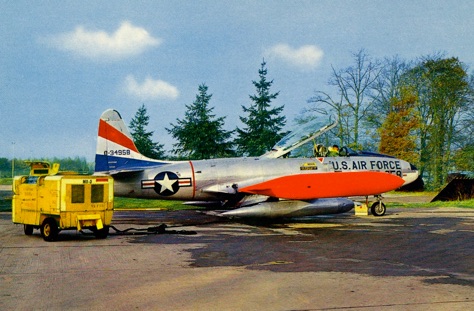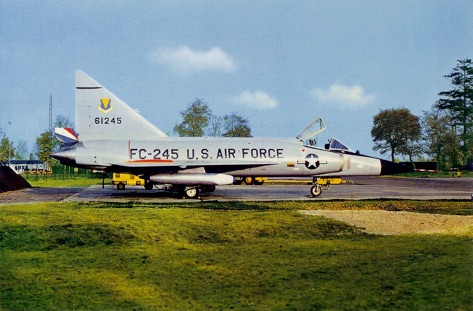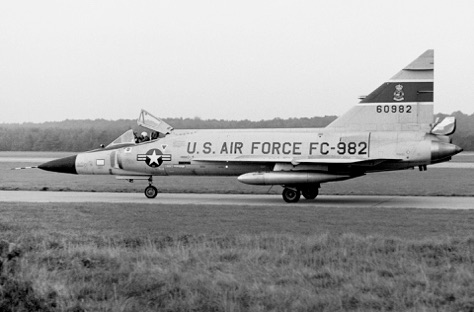overshoot.nl
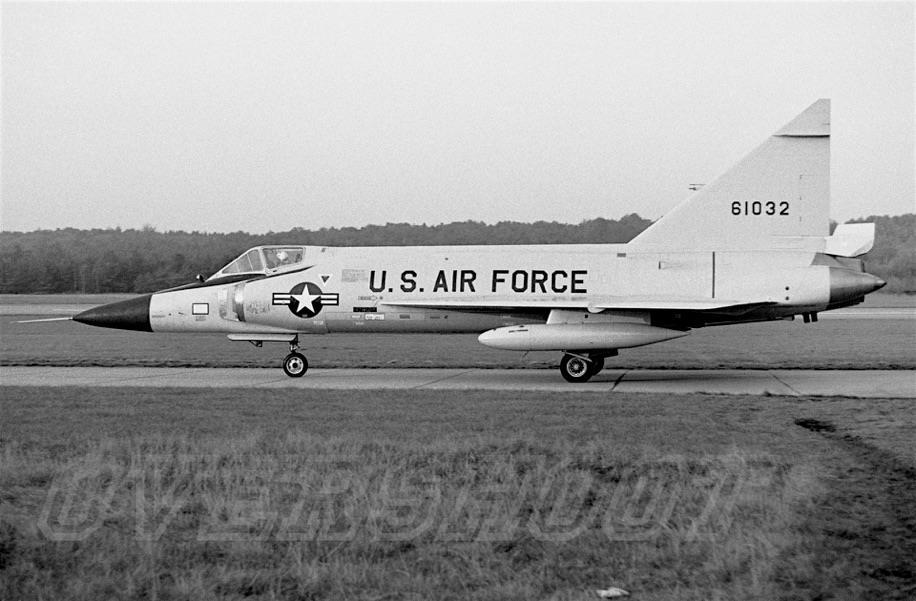
After more than one ‘operational’ year, the F-86F “Sabre” already would be replaced by the supersonic F-100C “Super Sabre”.
The F-100 was a very good looking machine, which could go faster than sound in the horizontal position. The enormous power of it’s
Pratt & Witney J-57 P-21A engine made it fly with a top-speed of more than 1300 km/ph. The only ‘disadvantage’ was the overwhelming
noise when the afterburner was put on just before takeoff. The F-100 “Super Sabre” could go more than 21 kilometers up into the sky.
With the arrival of the F-100C, the runway of Soesterberg A.B. first had to be lengthened up to more than 3 kilometers during 1956.
So, at the end of August 1956, the 32nd F.D.S. was fully equipped with the F-100C. By 1957 the strength had gone up to 24 machines.
Besides the 24 F-100C models, the squadron received a few F-100F two-seater (trainer) versions.
On july 8, 1958 the name was changed from 32nd Fighter Day Squadron to 32nd Tactical Fighter Squadron.
1959 Was the year, in which a crown and a wreath with twelve oranges were added to the Squadron’s insignia. At first the F-100’s flew
with the three green bands on the tail, but (also) in 1959 the tails were painted in the colours of the Dutch flag: red, white and blue (see
pictures below) and the squadron’s insignia could be found on the left side of the fuselage, beneath the cockpit.

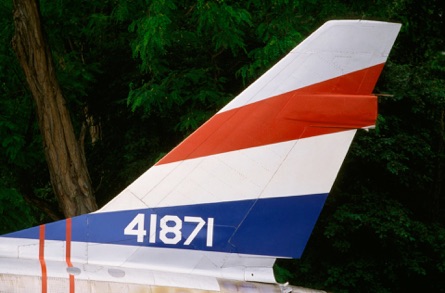
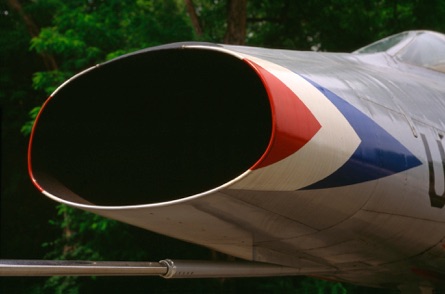

At the pictures above, taken at the M.L.M. (at Kamp Zeist), we can see the colour-sceme, as worn by the
F-100’s of 32nd T.F.S. from 1959 on. This aircraft, which represents ‘FW-871’ (54-1871), is in fact an ex-
Armée de l’Air F-100D-version “Super Sabre” with serial number 54-2265.
“Delta Daggers” of 32nd F.I.S.
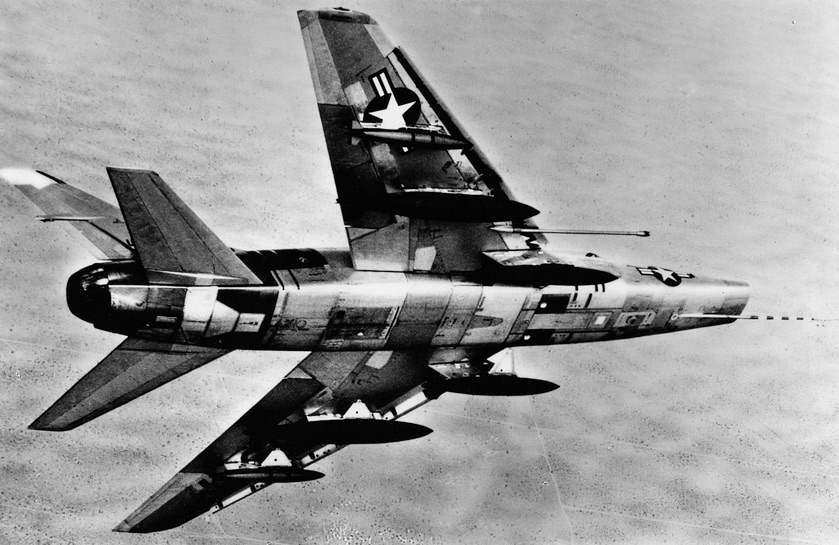
Picture of an F-100C seen from below. In the four years the 32nd T.F.S. was flying the F-100 “Super Sabre”, nine accidents occured in which five machines were lost.
Photo: Postcard. coll. C. Vermolen.
In 1959, the squadron received two T-33A “T-Birds”. They too were flying with the red, white and blue tail. Also in 1959 it was announced
that the next year, in1960, the 32nd Tactical Fighter Squadron was to receive a new type of aircraft: the Convair F-102A “Delta Dagger”.
Because this machine was especially designed for the interception role, 32nd “Tactical Fighter Squadron” was changed to 32nd “Fighter Interceptor Squadron” in July 1959. Within five months the conversion of the crew to the complex F-102 was completed and so at the end
of 1960, the squadron was at full strength with 21 machines (amongst which, were two TF-102A two-seaters).
These machines wore the same red, white and blue tail.

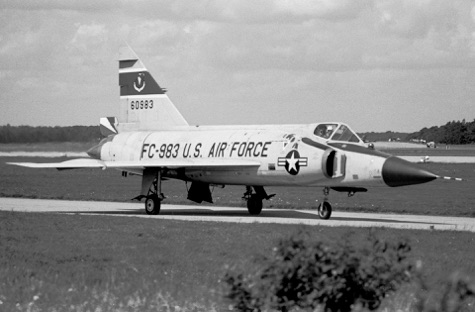
In 1965 one horizontal green band (between white linings) appeared on the tail. In this band, at the left
side, the Squadron’s insignia was visible and at the same spot on the right side, the insignia of the 86th
Air Division. The black & white photo’s above were taken at Soesterberg A.B. in 1966.
Photos: D. Heinen, coll. C. Vermolen.
In the second half of the nineteen sixties, the U.S. ‘first line’ combat aircraft were to be camouflaged, due to the experiences that were
made during the Vietnam War, into brown and green camouflage-colours. From November 1965 on, the F-102’s of the 32nd F.I.S. were
gradually camouflaged too.
When an F-102 of the 32nd F.I.S. was going to be camouflaged, the FC-code (buzz number) and the green
band with the squadron’s insignia first were removed. This aircraft, 56-1032 was flown by the commander.
Though the F-102’s sometimes were replaced by aircraft with other serials, the squadron normally had 21
“Delta Daggers” in use. Photo: D. Heinen, coll. C. Vermolen.
Click Here
In 1963 however the red, white and blue colours on the tail were removed and were now only to be found
on the speed-brake flaps. Later, on the port-side of the tail, the squadron’s insignia and on starboard-side
the insignia of the 86th Air Division could be found (picture on the left).
The “T-Birds” did fly longer with the red, white and blue colour sceme. The pictures above probably were
taken somewhere in 1964/65 at the American side of Soesterberg A.B. (Camp New Amsterdam).
Photos: KLu. Post Card. Gebr. Spanjersberg, coll. C. Vermolen.
